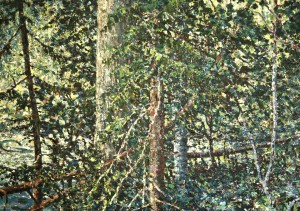Here are 10 common mistakes for artists to avoid. If this is your first time reading my blog, I’m a contemporary landscape artist. You can view my online landscape painting gallery here. The following mistakes are things I’ve learned over the years.
#1 Don’t sell all your great work.
Invest in yourself and hold on to some of the really good ones. Study the ones you keep and if you are going in the right direction you will discover their magic. I have pictures from thirty years ago and can now appreciate what took place inside the creative spirit that produced them.
#2 A little originality trumps the best imitation.
Be original–not necessarily different but at least distinctly you. In writing, they call it finding your voice. And this usually means when you stop imitating and begin to show the world your personal perspective on things. Originality is much more powerful than imitation—even if that imitation is highly polished.
#3 Don’t dig through the garbage looking for a crust of bread.
This has nothing to do about the starving artist thing; it’s about the people and places you try to use to further your career. Exhibiting your work is not a hang anywhere scenario. Be selective and exhibit professionally such as your studio (or home studio) or at a gallery. Restaurants, craft fairs, downtown parks, sidewalks, and the local bakery are usually easy places to show—but they might not be worth the effort. The lighting is dreadful and the clientele are not interested in buying art: they are there to eat, to walk in the park, or buy a coffee at the bakery. The most basic rule of marketing is to fish where the fish are. Exhibit in places where people come to view and buy art.
#4 Don’t neglect your natural talent.
It is innate and it is yours to nurture. I have a talent painting nature. I really enjoy sitting for 2 or 3 hours painting outdoors. It’s natural for me; I don’t force myself to do it. I feed this talent first and then attend to the rest. Identify your natural ability and develop it.
#5 Don’t bury yourself in your ego.
A reasonable amount of progress in a reasonable amount of time is a much healthier lifestyle than working on your craft 13 hours a day. Go for the marathon. Painting 15 hours a week (in the evenings, the early mornings) for 50 years is much more productive that working all night one day, and then not touching a brush for a few weeks. Integrate your craft into your daily life.
#6 Don’t get stuck in the studio.
Get ye to the high mountain and refresh your creative awareness by looking, sketching, enjoying, and appreciating nature. Or, if you are not a landscape artist, go down into the streets, hear people talk, and experience life.
#7 Don’t neglect OPPORTUNITY.
It might not knock on your door but it is out there.
#8 Study, study, study.
Read about great artists. Find out their struggles and joys. Look at their work and their contemporaries. Where do you fit? Will anybody read about you? Is that important to you? Why do you do what you do? Introspection helps your work become more original. Study them and grow.
#9 Don’t use inferior grade materials.
Bronze and stone are permanent. Use permanent materials only. If you can’t afford them then work smaller until you overcome that problem. Art needs to survive. And you will thank yourself later (in 30 years) for buying the better material.
#10 Don’t avoid struggle.
Overcome with perseverance and principals. Struggle is learning. It strengthens our weakness.
You can view Ron Mulvey’s contemporary landscape paintings here. Or take home a small original art work for only $40–ready to view, ship, and be ordered online in Ron’s online store. View and buy inexpensive art online here.
